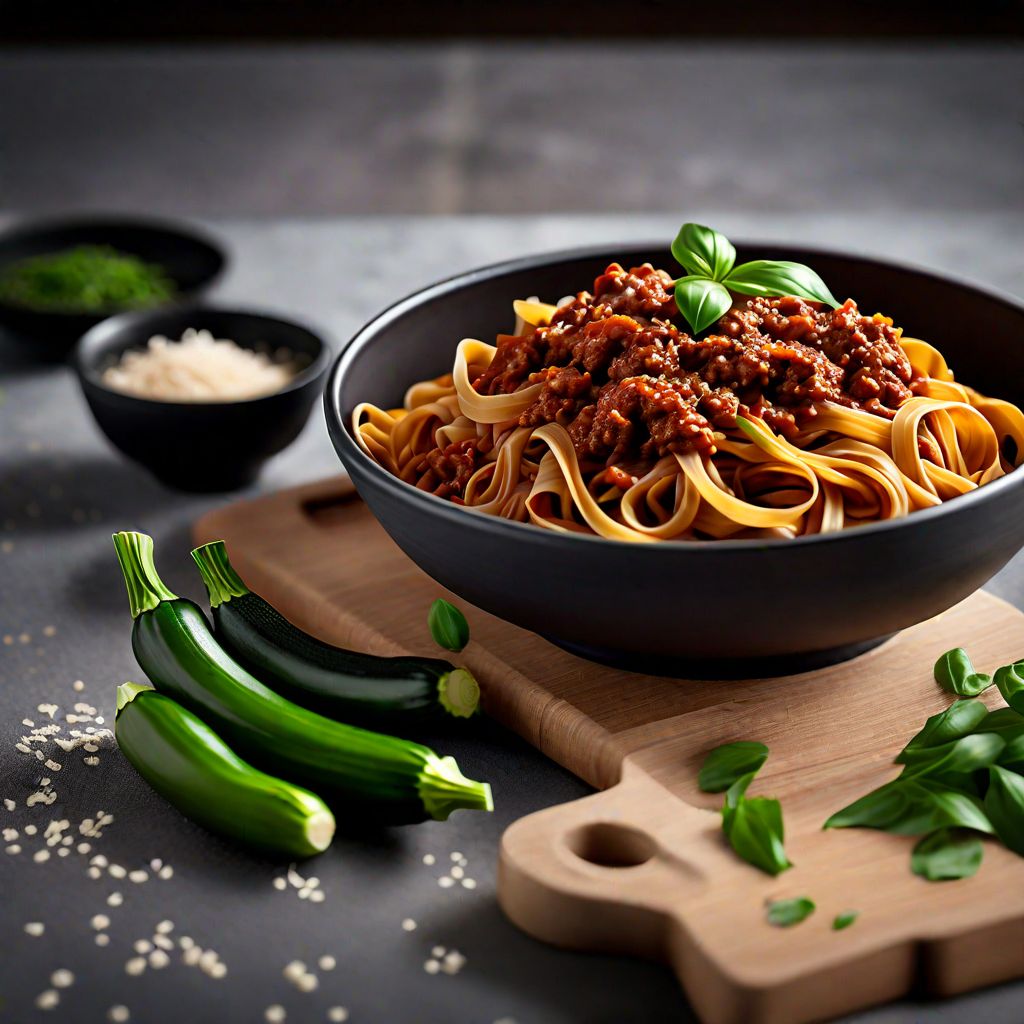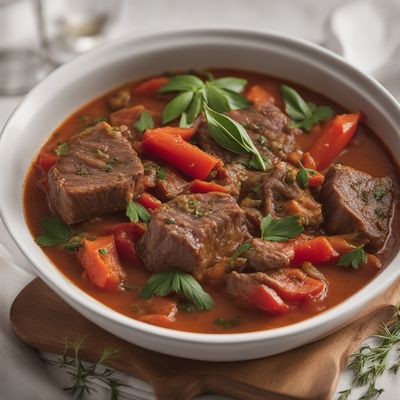
Recipe
Tagliatelle al ragù alla Bolognese
Korean-style Tagliatelle with Spicy Beef Sauce
4.8 out of 5
In Korean cuisine, we love bold flavors and spicy dishes. This Korean adaptation of the classic Italian dish, Tagliatelle al ragù alla Bolognese, combines the rich and meaty flavors of the original with a spicy kick. The result is a satisfying and comforting pasta dish that will surely delight your taste buds.
Metadata
Preparation time
20 minutes
Cooking time
25 minutes
Total time
45 minutes
Yields
4 servings
Preparation difficulty
Easy
Suitable for
Omnivore, Gluten-free (if using gluten-free soy sauce and noodles), Dairy-free, Nut-free, Low sugar
Allergens
Soy
Not suitable for
Vegetarian, Vegan, Paleo, Keto, Low-carb
Ingredients
While the original Italian version of Tagliatelle al ragù alla Bolognese uses a slow-cooked meat sauce, this Korean adaptation adds a spicy twist to the dish. The Korean version incorporates gochujang, a fermented chili paste, to give the sauce a fiery kick. Additionally, the pasta is replaced with Korean-style noodles, such as udon or dangmyeon, to create a fusion of flavors. We alse have the original recipe for Tagliatelle al ragù alla Bolognese, so you can check it out.
-
300g (10.5 oz) Korean-style noodles (udon or dangmyeon) 300g (10.5 oz) Korean-style noodles (udon or dangmyeon)
-
300g (10.5 oz) ground beef 300g (10.5 oz) ground beef
-
1 onion, finely chopped 1 onion, finely chopped
-
2 cloves of garlic, minced 2 cloves of garlic, minced
-
1 carrot, finely diced 1 carrot, finely diced
-
1 zucchini, finely diced 1 zucchini, finely diced
-
2 tablespoons gochujang (Korean chili paste) 2 tablespoons gochujang (Korean chili paste)
-
2 tablespoons soy sauce 2 tablespoons soy sauce
-
1 tablespoon sesame oil 1 tablespoon sesame oil
-
1 tablespoon vegetable oil 1 tablespoon vegetable oil
-
Salt and pepper to taste Salt and pepper to taste
-
Chopped green onions, for garnish Chopped green onions, for garnish
Nutrition
- Calories: 450 kcal / 1884 KJ
- Fat: 15g (6g saturated)
- Carbohydrates: 55g (8g sugars)
- Protein: 25g
- Fiber: 5g
- Salt: 2g
Preparation
-
1.Cook the Korean-style noodles according to the package instructions. Drain and set aside.
-
2.Heat vegetable oil in a large pan over medium heat. Add the chopped onion and minced garlic, and sauté until fragrant.
-
3.Add the ground beef to the pan and cook until browned, breaking it up with a spoon.
-
4.Stir in the diced carrot and zucchini, and cook for another 2-3 minutes until slightly softened.
-
5.In a small bowl, mix together the gochujang, soy sauce, and sesame oil. Pour the sauce into the pan and stir well to coat the meat and vegetables.
-
6.Reduce the heat to low and simmer the sauce for 10-15 minutes, allowing the flavors to meld together. Season with salt and pepper to taste.
-
7.Add the cooked noodles to the pan and toss them with the sauce until well combined.
-
8.Serve the Korean-style Tagliatelle al ragù alla Bolognese hot, garnished with chopped green onions.
Treat your ingredients with care...
- Ground beef — Make sure to use lean ground beef for a healthier option. You can also substitute it with ground chicken or turkey if desired.
- Gochujang — Adjust the amount of gochujang according to your spice preference. Add more for extra heat or reduce it for a milder flavor.
- Korean-style noodles — If you can't find Korean-style noodles, you can use regular spaghetti or linguine as a substitute.
Tips & Tricks
- For a richer flavor, you can add a splash of beef or vegetable broth to the sauce while simmering.
- Feel free to add additional vegetables such as mushrooms or bell peppers for extra texture and flavor.
- If you prefer a less spicy version, you can reduce the amount of gochujang or use a milder chili paste.
- Garnish the dish with toasted sesame seeds for added crunch and nuttiness.
- Serve the Korean-style Tagliatelle al ragù alla Bolognese with a side of kimchi for a traditional Korean touch.
Serving advice
Serve the Korean-style Tagliatelle al ragù alla Bolognese hot, straight from the pan. It pairs well with a side of kimchi and a refreshing cucumber salad.
Presentation advice
To make the dish visually appealing, garnish it with a sprinkle of chopped green onions and toasted sesame seeds. Serve it in individual bowls or on a large platter for sharing.
More recipes...
For Tagliatelle al ragù alla Bolognese » Browse all
For Italian cuisine » Browse all
More Italian cuisine dishes » Browse all

Panettone
Panettone is an Italian sweet bread that is typically served during the Christmas season. It is a light and fluffy bread that is filled with...

Riso e salvia
Sage and Rice
Riso e salvia is an Italian dish that features risotto flavored with fresh sage. It is a simple yet flavorful dish that is perfect for a cozy...

Panelle
Chickpea fritter sandwich
Panelle is a popular Sicilian street food that is made with chickpea flour and a variety of spices. This dish is a great option for vegetarians...
More Korean cuisine dishes » Browse all

Jangjorim
Soy-braised beef
Jangjorim is a traditional Korean dish that is made with beef and soy sauce. It is a popular side dish that is often served with rice or used as a...

Budae jjigae
Korean Army Stew
Budae jjigae is a popular Korean stew that is made with a variety of ingredients, including spam, hot dogs, and instant noodles. It is a hearty...

Samgyetang
Samgyetang is a traditional Korean dish made with a whole chicken that is stuffed with rice, ginseng, and other herbs. It is a hearty and...











